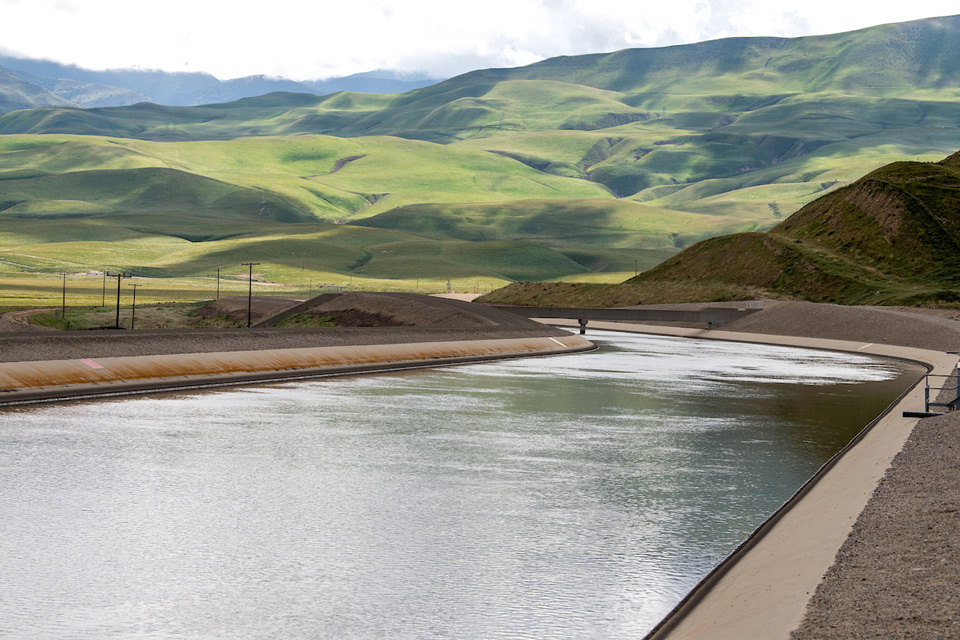A section of the California Aqueduct within the California State Water Project, located near Wheeler Ridge, which convey California Aqueduct water between Ira J. Chrisman Wind Gap and Edmonston Pumping Plants within Kern County. In the background is the Tehachapi Mountains. DWR/2019
February 22, 2023 - SACRAMENTO, Calif. – The Department of Water Resources (DWR) today announced a modest increase in forecasted State Water Project (SWP) deliveries this year due to early gains in the Sierra snowpack. DWR now expects to deliver 35 percent of requested water supplies, up from 30 percent forecasted in January, to the 29 public water agencies that serve 27 million Californians. That would translate to an additional 210,000 acre-feet of water.
Record-breaking atmospheric rivers that pounded the state in January gave way to a mostly dry February that saw less than an inch of precipitation statewide to this point.
“We’re hopeful that more storms this week are a sign that the wet weather will return, but there remains a chance that 2023 will be a below average water year in the northern Sierra.” said DWR Director Karla Nemeth. “Careful planning and the use of advanced forecasting tools will enable the Department to balance the needs of our communities, agriculture, and the environment should dry conditions continue this spring and into next year.”
The SWP will continue to optimize water storage in Lake Oroville to support environmental needs in the summer and allow for carryover storage for next year if the spring becomes extremely dry. Additionally, the forecasted allocation could be adjusted back down if extreme dry conditions warrant.
The 35 percent allocation forecast announced today takes into account snowpack and reservoir storage from those storms, current hydrology conditions, spring runoff forecasts, and an anticipation of dry conditions ahead. The updated SWP forecast is on par with the Central Valley Project (CVP) initial allocations announced today by the U.S. Bureau of Reclamation.
In addition to optimizing water storage, California continues to accelerate investments in habitat restoration, including $52 million in grants announced last week to help restore and protect fish and wildlife habitat throughout California.
Today’s updated SWP delivery forecast takes into account new snowmelt runoff data, known as Bulletin 120. This report provides a forecast of snowmelt runoff and is a key tool for water managers across the state to understand how the melting snow in the Sierra Nevada will reach streams, rivers and eventually California reservoirs. Bulletin 120 offers a range of possibilities to allow water managers to prepare for spring runoff and eventual summer water supply. The forecast is updated regularly throughout the winter and spring.
DWR uses advanced forecasting tools that include Airborne Snow Observatory (ASO) surveys which are now underway to collect snow measurements farther upslope of the Sierra Nevada. The data from these flights, which use LiDAR and spectrometer technology to measure snowpack across broad swaths of key watersheds, is used by DWR to get a more accurate account of California’s snowpack and possible spring runoff.
More than a month still remains in the state’s wet season, but there’s uncertainty about a return to warm and dry conditions prior to April 1, typically when the state’s snowpack peaks and begins to melt. DWR is scheduled to conduct the next two snow surveys at Phillips Station on March 1 and April 3. Dates are subject to change depending on weather conditions and DWR will provide updates as the date approaches.
Conditions in the Colorado River Basin and California’s groundwater basins continue to have an impact on available water supply. Californians should continue to use water wisely to help the state adapt to a hotter, drier future.
Resources
- Latest on California’s Drought Response
- Current Statewide Reservoir Conditions
- Save Our Water: Tips to Conserve Water During a Drought
Source: CA. DWR









